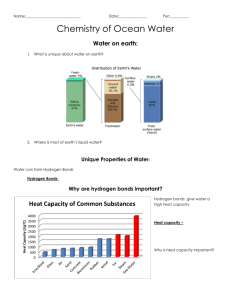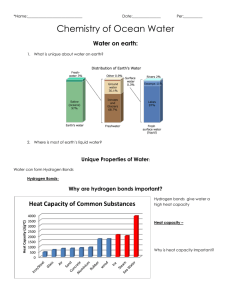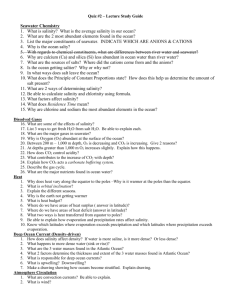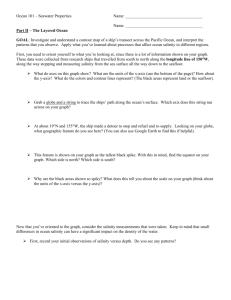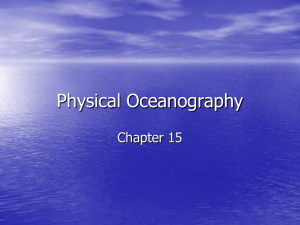Chapters 678 exam review answers
advertisement
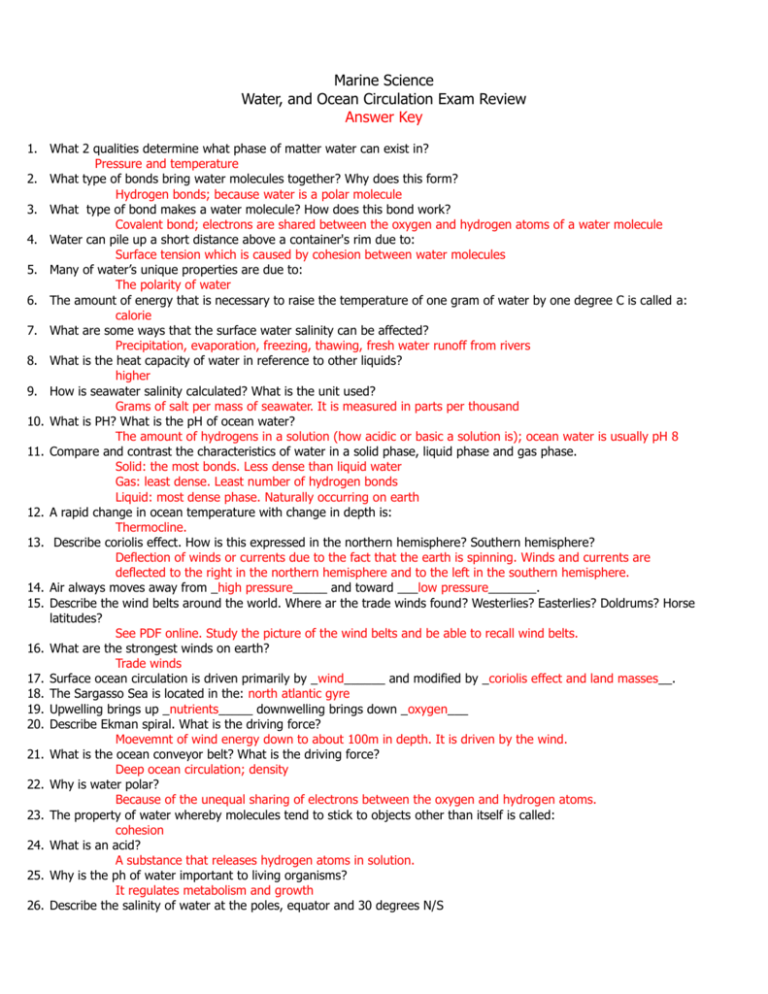
Marine Science Water, and Ocean Circulation Exam Review Answer Key 1. What 2 qualities determine what phase of matter water can exist in? Pressure and temperature 2. What type of bonds bring water molecules together? Why does this form? Hydrogen bonds; because water is a polar molecule 3. What type of bond makes a water molecule? How does this bond work? Covalent bond; electrons are shared between the oxygen and hydrogen atoms of a water molecule 4. Water can pile up a short distance above a container's rim due to: Surface tension which is caused by cohesion between water molecules 5. Many of water’s unique properties are due to: The polarity of water 6. The amount of energy that is necessary to raise the temperature of one gram of water by one degree C is called a: calorie 7. What are some ways that the surface water salinity can be affected? Precipitation, evaporation, freezing, thawing, fresh water runoff from rivers 8. What is the heat capacity of water in reference to other liquids? higher 9. How is seawater salinity calculated? What is the unit used? Grams of salt per mass of seawater. It is measured in parts per thousand 10. What is PH? What is the pH of ocean water? The amount of hydrogens in a solution (how acidic or basic a solution is); ocean water is usually pH 8 11. Compare and contrast the characteristics of water in a solid phase, liquid phase and gas phase. Solid: the most bonds. Less dense than liquid water Gas: least dense. Least number of hydrogen bonds Liquid: most dense phase. Naturally occurring on earth 12. A rapid change in ocean temperature with change in depth is: Thermocline. 13. Describe coriolis effect. How is this expressed in the northern hemisphere? Southern hemisphere? Deflection of winds or currents due to the fact that the earth is spinning. Winds and currents are deflected to the right in the northern hemisphere and to the left in the southern hemisphere. 14. Air always moves away from _high pressure_____ and toward ___low pressure_______. 15. Describe the wind belts around the world. Where ar the trade winds found? Westerlies? Easterlies? Doldrums? Horse latitudes? See PDF online. Study the picture of the wind belts and be able to recall wind belts. 16. What are the strongest winds on earth? Trade winds 17. Surface ocean circulation is driven primarily by _wind______ and modified by _coriolis effect and land masses__. 18. The Sargasso Sea is located in the: north atlantic gyre 19. Upwelling brings up _nutrients_____ downwelling brings down _oxygen___ 20. Describe Ekman spiral. What is the driving force? Moevemnt of wind energy down to about 100m in depth. It is driven by the wind. 21. What is the ocean conveyor belt? What is the driving force? Deep ocean circulation; density 22. Why is water polar? Because of the unequal sharing of electrons between the oxygen and hydrogen atoms. 23. The property of water whereby molecules tend to stick to objects other than itself is called: cohesion 24. What is an acid? A substance that releases hydrogen atoms in solution. 25. Why is the ph of water important to living organisms? It regulates metabolism and growth 26. Describe the salinity of water at the poles, equator and 30 degrees N/S 27. 28. 29. 30. 31. 32. SEE Powerpoint. Equator: low salinity due to high precipitation and low evaporation 30 N/S: high due to high evaporation and low precipitation Which gasses are regulated by biological processes? Oxygen and carbon dioxide due to photosynthesis and respiration Where is the OML found? Oxygen minimum layer is found just under the photic zone at around 1000m in depth. What is the buffer in seawater bicarbonate What is the formula for density? Mass/volume What 2 main factors control the density of sea water? Salinity and temperature What is isopycnal? Water column with all the same density with depth.


